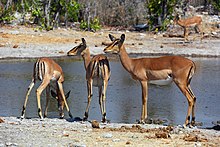Depression (geology)

A watering hole is a natural depression where water collects and animals come to drink

Karst closed depression with permanent lake Stymfalia, Peloponnese, Greece. Seasonal abundant precipitation drained by 3 sinkholes
In geology, a depression is a landform sunken or depressed below the surrounding area. Depressions form by various mechanisms.
Erosion-related:
- Blowout: a depression created by wind erosion typically in either a partially vegetated sand dune ecosystem or dry soils (such as a post-glacial loess environment).[1]
- Glacial valley: a depression carved by erosion by a glacier.
- River valley: a depression carved by fluvial erosion by a river.
- Area of subsidence caused by the collapse of an underlying structure such as sinkholes in karst terrain.
- Sink: an endorheic depression generally containing a persistent or intermittent (seasonal) lake, a salt flat (playa) or dry lake, or an ephemeral lake.
- Panhole: a shallow depression or basin eroded into flat or gently sloping cohesive rock.[2]
Collapse-related:
- Sinkhole: a depression formed as a result of the collapse of rocks lying above a hollow. This is common in karst regions.
- Kettle: a shallow, sediment-filled body of water formed by melting glacial remnants in terminal moraines.[3]
- Thermokarst hollow: caused by volume loss of the ground as the result of permafrost thawing.
Impact-related:
- Impact crater: a depression created by an impact such as a meteorite crater.
Sedimentary-related:
- Sedimentary basin: in sedimentology, an area thickly filled with sediment[1] in which the weight of the sediment further depresses the floor of the basin.
Structural or tectonic-related:
- Structural basin: a syncline-like depression; a region of tectonic downwarping as a result of isostasy (the Hawaiian Trough is an example) or subduction (such as the Chilean Central Valley).
- Graben or rift valley: fallen and typically linear depressions or basins created by rifting in a region under tensional tectonic forces.
- Pull-apart basin caused by offset in a strike slip or transform fault (example: the Dead Sea area).
- Oceanic trench: a deep linear depression on the ocean floor. Oceanic trenches are caused by subduction (when one tectonic plate is pushed underneath another) of oceanic crust beneath either oceanic crust or continental crust.
- A basin formed by an ice sheet: an area depressed by the weight of the ice sheet resulting in post-glacial rebound after the ice melts (the area adjacent to the ice sheet may be pulled down to create a peripheral depression.)[4]
Volcanism-related:
- Caldera: a volcanic depression resulting from collapse following a volcanic eruption.[5]
- Pit crater: a volcanic depression smaller than a caldera formed by a sinking, or caving in, of the ground surface lying over a void.
- Maar: a depression resulting from phreatomagmatic eruption or diatreme explosion.
See also[]
References[]
- ^ Jump up to: a b "Dictionary of Geologic Terms – B". US Geochemical. Retrieved 2017-09-09.
- ^ Twidale, C.R., and Bourne, J.A., 2018. Rock basins (gnammas) revisited. Géomorphologie: relief, processus, environnement, Vol. 24, No. 2. January 2018. Retrieved 9 June 2020. doi:10.4000/geomorphologie.11880
- ^ "Dictionary of Geologic Terms – K". US Geochemical. Retrieved 2017-09-09.
- ^ "Glossary of Important Terms in Glacial Geology – Peripheral Depression". Montana State University. 1999. Archived from the original on 2006-08-29. Retrieved 2006-08-25. Cites American Geological Institute's Glossary of Geology (3rd edition, revised in 1987).
- ^ "Dictionary of Geologic Terms – C". US Geochemical. Retrieved 2017-09-09.
Categories:
- Depressions (geology)
- Geology stubs